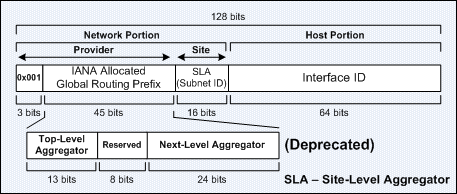Aggregatable Global Unicast Address Format
The figure above shows the format and bit allocation of an Aggregatable Global Unicast Address. This structure allows route summarization that reduces the number of routing entries in the global routing table. RFC 3587 – IPv6 Global Unicast Address Format specifies a new format which obsoletes and simplifies the old format which includes the Top-Level Aggregator (TLA) and Next-Level Aggregator (NLA).
Global Routing Prefix in an IPv6 address is globally unique and can be routed throughout the Internet; it serves the same purpose as public IPv4 address. The 1st 48 bits of the address is a allocated by the IANA [1] for external routing within the Internet, with the fixed prefix of 001 in binary (2000::/3 – 2000::/4 or 3000::/4 in hexadecimal) to indicate a global IPv6 address.
[1] IANA – Internet Assigned Numbers Authority (www.iana.org).
Site Level Aggregator (SLA) or Subnet Identifier is the address that is used by organizations to create local addressing hierarchy for routing and identifying the subnets within an AS. It can be used without the 48-bit prefix assigned by the IANA. If the global routing prefix is not used, the addressing scheme is similar to IPv4 private addressing, and the AS must not be connected to the Internet. This field allows the creation up to 65,536 (216) subnets.
Pay attention to the subnetting concept of IPv6. The SLA or Subnet ID is considered as a part of the network portion of an IPv6 address rather than the host portion as with IPv4! When performing subnetting in IPv4, the host portion of an IPv4 address shrinks and borrowed to create the subnet portion of an IPv4 address. The advantage of defining the IPv6 Subnet ID as a part of the network portion is that the size of the Interface ID can be consistent for all IPv6 addresses, which simplifies the parsing of IPv6 addresses. This also creates a clear separation in which the network portion provides the location of a device down to the specific data link segment while the host portion provides the identity of a device on a particular data link segment.
The Interface ID is used to identify interfaces on a link (network) and it must be unique on a particular link. Interface IDs are used in IPv6 unicast addresses and often autoconfigured with the MAC address of an interface in the Extended Unique Identifier-64 (EUI-64) format.
Below are some important rules when constructing an Interface ID in the EUI-64 format.
i) For IEEE 802 interface types (eg: Ethernet, FDDI), insert 0xFFFE between the upper 3 bytes OUI (24 bits) and the lower 3 bytes NIC serial number (24 bits) of a MAC address, and set the Universal/Local (U/L) bit (the 7th bit of the 1st octet) to binary 0 or 1. A value of 0 indicates a locally administered identifier, and a value of 1 indicates a globally unique IPv6 Interface ID. Note: By the way, the 7th bit of OUI is always 0.
Ex: MAC address > 1111.1122.2222, EUI-64 > 1311.11FF.FE22.2222.
ii) For other interface types (eg: serial, ATM, Frame Relay, loopback, and tunnel interfaces that are not being used with IPv6 overlay tunnels), the 1st MAC address of the router is used to construct the Interface ID with the same method above.
iii) For tunnel interface types that are used with IPv6 overlay tunnels, the Interface ID is construct with the source IPv4 address for the tunnel with all 0s in the first 32 bits.
Ex: With 172.16.0.1 as the source IPv4 address for the tunnel, the link-local address for the tunnel interface is FE80::AC10:1.

No comments:
Post a Comment